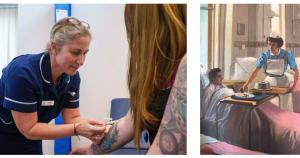Find out about Ladybird Books
About the Ladybird Books

The People at Work titles from the 1960s reflect the traditional gender expectations of the time in the world of work. Jobs are clearly divided into roles acceptable ‘for men’ – chef, hotel manager, railwayman, doctor, policeman and postman; and ‘for women’ or ‘girls’ – nurse, hotel receptionist, room-maid, sales assistant, seamstress and radio operator.
After the Second World War there were many social and economic changes which saw the number of women in the workplace increase. The Office of National Statistics recorded 8.35 million working women in the 1960s, the professions and focus of the books did not feature many of those women, perhaps reflecting the perceived lower status of women’s contribution in the workplace.
 There is also a lack of ethnic diversity within the books. A labour shortage following the Second World War led to Britain looking to Commonwealth citizens to work in the areas where there were shortages, mainly transport, manufacturing and the NHS. By 1961, according to the national population census, the number of people living in England and Wales who were born in the Caribbean was just over 161,000: 90,000 men and just over 71,000 women.
There is also a lack of ethnic diversity within the books. A labour shortage following the Second World War led to Britain looking to Commonwealth citizens to work in the areas where there were shortages, mainly transport, manufacturing and the NHS. By 1961, according to the national population census, the number of people living in England and Wales who were born in the Caribbean was just over 161,000: 90,000 men and just over 71,000 women.
As society and the workplace has evolved, some of these changes were reflected in the books, but we are conscious of the lack of diversity and the stereotypical nature of the roles portrayed. In this exhibition we have consulted local working people from four occupations represented in the books, to give their thoughts and reactions today, and to reflect on how the professions illustrated have changed since 1962. We are extremely grateful to all who took part.
To find out more please contact helen.murray@leics.gov.uk
